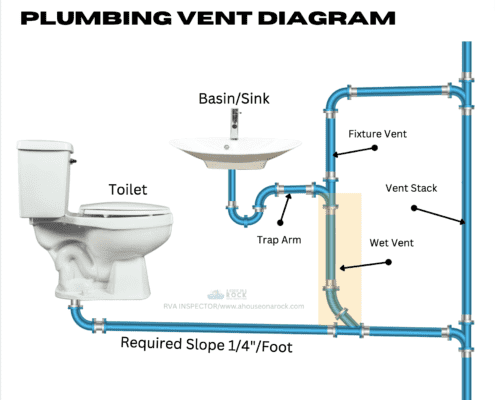Proper Ventilation in Plumbing Systems: Why It Is Essential
Proper Ventilation in Plumbing Systems: Why It Is Essential
Blog Article
Right here in the next paragraphs you will find additional amazing expertise with regards to What Are Plumbing Vents and Why Are They Important?.

Appropriate ventilation in pipes systems is often forgotten, yet it is critical for keeping the functionality and safety and security of your home's pipes. Ventilation aids control air pressure, protect against the accumulation of damaging gases, and ensure the effective removal of waste. In this guide, we will discover the significance of appropriate plumbing ventilation, exactly how it works, and the benefits it offers your pipes system.
Comprehending Ventilation in Plumbing
Air flow in plumbing refers to the network of pipes that allow air to stream via the drainage system. These vents serve multiple functions, including controling atmospheric pressure within the pipelines, avoiding sewage system gases from getting in the home, and assisting in the smooth circulation of wastewater.
Just How Air Flow Functions in Pipes Solutions
Air Pressure Policy
Proper air flow maintains balanced atmospheric pressure within the pipes system. When water streams through pipes, it displaces air. Without adequate air flow, this variation can create negative stress, resulting in reduce drains or siphoning of water from traps, which can trigger unpleasant smells to leak into the home.
Protecting Against Drain Gas Buildup
Among the most crucial functions of pipes vents is to prevent drain gases, such as methane and hydrogen sulfide, from accumulating within the home. These gases can position significant health and wellness risks and are highly flammable. Vent pipelines permit these gases to get away securely outdoors.
Assisting in Waste Removal
Air flow helps in the efficient elimination of wastewater by avoiding airlocks in the drainage system. When air can flow easily with the vents, it enables water and waste to move smoothly via the pipes, reducing the risk of clogs and back-ups.
Kinds Of Plumbing Vents
Main Heap Vent
The major pile vent, also known as the air vent stack, is the key air vent in a plumbing system. It expands from the major drain align through the roof covering, enabling gases to get away and fresh air to enter the system.
Branch Vent
Branch vents link to the main stack air vent and serve private fixtures, such as sinks, bathrooms, and showers. These vents ensure that each fixture has appropriate air flow to work properly.
Air Admittance Valve (AAV).
An Air Admission Valve (AAV) is a one-way valve that enables air to go into the plumbing system without the requirement for a typical vent pipeline expanding through the roof covering. AAVs are generally used in restorations or locations where mounting a basic vent is unwise.
Indications of Poor Ventilation in Pipes.
Slow Draining Fixtures.
If your sinks, bathtubs, or commodes are draining pipes gradually, it could be an indicator of bad air flow. Poor air circulation can produce a vacuum result, making it tough for water to drain correctly.
Gurgling Sounds.
Gurgling audios coming from drains pipes are typically an outcome of air being sucked through water catches as a result of unfavorable stress in the pipelines. This is a clear indicator of not enough air flow.
Unpleasant Odors.
Sewage system smells inside your home are a warning that your pipes system is not appropriately aerated. This might imply that drain gases are not being properly vented outside, bring about possibly unsafe problems.
Usual Air Flow Errors.
Insufficient Vent Sizing.
Utilizing undersized vent pipes can lead to bad air flow and pressure imbalances in the system. It's necessary to use vents that fulfill the specific requirements of your pipes system.
Improper Vent Placement.
Placing vents also much from the fixtures they serve can reduce their efficiency. Appropriate positioning makes sure that air can flow freely and successfully through the system.
Disregarding Code Needs.
Building codes supply certain standards for pipes ventilation. Disregarding these codes can cause a system that fails to operate correctly and may bring about costly repair services or carcinogen.
Benefits of Proper Ventilation.
Improved System Performance.
Properly ventilated plumbing systems operate more effectively, with fewer blockages, faster draining, and less strain on the pipes. This effectiveness prolongs the life expectancy of the pipes system.
Improved Air Quality.
By avoiding sewage system gases from entering your home, appropriate air flow adds to far better interior air high quality, making your living setting healthier and more comfy.
Avoiding Water Damages.
Adequate air flow aids stop water from being siphoned out of catches, which can cause sewage system gases entering the home and creating water damage in time.
Steps to Make Sure Appropriate Air Flow.
Consulting Pipes Codes.
Constantly get in touch with neighborhood pipes codes when developing or modifying your pipes system. These codes provide the required guidelines for correct venting and ensure your system fulfills security criteria.
Routine Evaluation and Upkeep.
Normal assessments can assist determine potential ventilation concerns prior to they come to be significant issues. Upkeep tasks, such as cleaning up vent pipes and checking for clogs, are crucial for maintaining the system in good working order.
Specialist Installment.
For brand-new installations or major adjustments, it's wise to hire a specialist plumbing. They have the competence to guarantee the ventilation system is appropriately made and set up according to code.
Conclusion.
Appropriate ventilation is a critical element of any kind of pipes system, guaranteeing that it functions successfully and securely. By comprehending the importance of ventilation, identifying the indications of inadequate air flow, and taking steps to keep your system, you can avoid pricey concerns and secure your home's air top quality.
4 Things You Should Know About Your Plumbing Vents
What Plumbing Vents Are
Also called a vent stack, a plumbing vent is a vertical pipe attached to your drain line that runs through your roof. The plumbing vent pipe, or plumbing air vent, removes gas and odors from your plumbing system and allows fresh air to enter the pipes, helping the water to flow out of the drain pipes.
What Plumbing Vents Do
Plumbing vents have two basic functions. One of which is to allow unpleasant smelling wastewater and sewer gasses to escape your plumbing system instead of entering your home. Plumbing vent pipes are typically located on roofs, away from windows, to ensure the fumes exit the home completely.
The other function of the plumbing vent is to move fresh air into your plumbing system. This helps move water through every plumbing fixture in your house, like toilets and sink drains. Think of the way in which you need to let a little air into the bottle as you pour soda in order to make the drink flow smoothly.
Different Types of Plumbing Vents
True vent: This is the most common vent option. In simplest terms, a true vent is a vertical pipe attached to your drain line that exits through the roof. They often function as the main vent that other fixtures can connect to. Re-vent pipe or auxiliary vent: Attached to the drain line near specific plumbing fixtures, re-vent pipes run up and over to connect to the main vent. Common vent: Two plumbing fixtures installed on opposite sides of a wall are typically tied into the vent stack using something known as a sanitary cross. Wet vent: This venting option operates as a drain pipe and a vent at the same time. Wet vent drainage systems drain water from one fixture while venting the air from another. Although they’ve been used for over 100 years, wet vent systems have only recently been added to the plumbing code in many areas. If you’re planning on installing one in a bathroom remodel, make sure you check your local code prior to construction. Loop vent: For free-standing fixtures like kitchen island sinks, loop vents are ideal. These vent pipes run under the floor, rise from the P-trap, and create a loop inside the cabinet sink. Air admittance valve: An AAV is a one-way mechanical valve typically installed at the site of the plumbing fixture. AAVs allow venting to occur without having to tie into a larger venting system. They’re ideal for venting fixtures where you aren’t able to easily connect to an existing vent system. Common Plumbing Vent Issues
Although vent pipes typically don’t have water flowing through them, they’re still subject to many typical plumbing issues. For example, clogs are one of the most common problems associated with sewer vent pipes. If your vent pipe gets clogged, all of your plumbing fixtures tied into the vent stack will be affected.
A sink with a slow drain that bubbles and gurgles or a strong sewage smell around your toilet are both indicators that your toilet vent pipe is clogged. Because most vent pipes exit through the roof, old leaves, twigs or even a bird’s nest could be clogging the pipe.
Clogs in your vent pipe system cause a buildup of negative pressure, meaning that water won’t be able to flow out of your home very well. It’s similar to putting your finger over the opening of a straw to trap water inside. When you remove your finger, the water is able to flow out of the straw.
If you suspect you have any blockage in your vent, make sure you have a professional come examine the situation. Left unchecked, a blocked air vent can lead to other costly repairs, like leaks and sediment buildup.
Under Pressure
Pipe vents are essential aspects of a home’s plumbing system. Owning a home means learning about all sorts of things you never put much thought into before. But by understanding as much as you can about the important systems of your home, you can keep those budgets intact and those anxiety levels low.
https://www.homeserve.com/en-us/blog/home-improvement/plumbing-vents/

As an avid reader on Why Plumbing Air Vents Are Important, I was thinking sharing that piece of content was a smart idea. So long as you enjoyed our article if you please do not forget to pass it around. Thank you so much for taking the time to read it.
Estimating Report this page